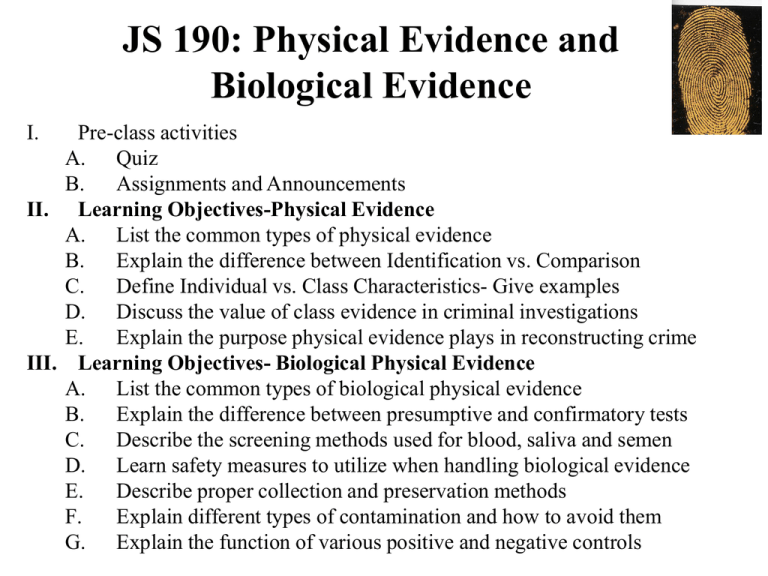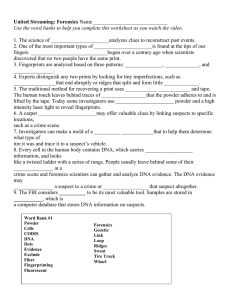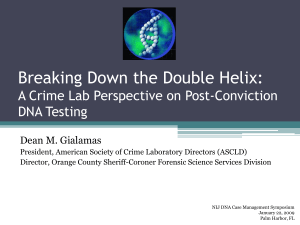Physical Evidence
advertisement

JS 190: Physical Evidence and Biological Evidence I. Pre-class activities A. Quiz B. Assignments and Announcements II. Learning Objectives-Physical Evidence A. List the common types of physical evidence B. Explain the difference between Identification vs. Comparison C. Define Individual vs. Class Characteristics- Give examples D. Discuss the value of class evidence in criminal investigations E. Explain the purpose physical evidence plays in reconstructing crime III. Learning Objectives- Biological Physical Evidence A. List the common types of biological physical evidence B. Explain the difference between presumptive and confirmatory tests C. Describe the screening methods used for blood, saliva and semen D. Learn safety measures to utilize when handling biological evidence E. Describe proper collection and preservation methods F. Explain different types of contamination and how to avoid them G. Explain the function of various positive and negative controls Assignments and Announcement • Announcements – Weds 29 Feb Dr. Cristian Orrego UC Berkeley Center for Human Rights • Required assignments for 01 Feb – Read Sample Handling Considerations (T Spear): http://www.cacnews.org/pdfs/DNA%20SampleHandling.pdf- Write a 500 word summary and 3 essay questions and 3 answers – Bring your laboratory notebooks next time. We will conduct a pipetting exercise. – Read Jones article from Saferstein*** need to copy and distribute and/or – Gaensslen article from Wecht (to be distributed electronically). "This is evidence that does not forget. It is not confused by the excitement of the moment. It is not absent because human witnesses are, it is factual evidence, physical evidence cannot be wrong, it cannot perjure itself...only its interpretation can err." -Paul L. Kirk, 1974. Physical Evidence Any material either in gross or trace quantities that can establish through scientific examination and analysis that a crime has been committed. Physical evidence utilization in other areas of forensic investigation • Provides investigative leads for a case • Ties one crime to a similar crime or connects one suspect with another • Corroborates statements from witnesses to or victims of a crime Common types of Physical evidence • • • • • • • • • • Blood, semen, saliva, hair, human or animal, biological samples Documents-handwriting, type, ink, indented, obliterations, burned Drugs-illegal substance-sale , manufacture, distribution, use Explosives- explosive charge material and residues Fibers, Hair, Paint Fingerprints, latent and visible Firearms and ammunition Glass-particles, fragments Impressions- tire marks, shoeprints, tracks, bite marks Organs and physiological fluids-existence of drugs or poisons, alcohol • • • • • • • • • Petroleum products-e.g. gas residues, grease or oil Plastic bags-e.g. garbage bag in homicide or drug case Rubber, other polymers- remnants linked to objects recovered in suspects possession Powder residues- gun powder Serial numbers- ID numbers Soil and minerals-e.g. soil in shoes or safe insulation Tool marks-object containing impression of another object Vehicle lights- filament condition Wood and other vegetative matterwood, sawdust, plant material, linking person or object to the crime scene Types of physical evidence • BODY FLUIDS Conventional serology: presence of blood in stains species identification and ABO grouping is not adequately informative to positive identify a person DNA analysis can associate victim and/or suspect with each other or with the crime scene • BLOODSTAIN PATTERNS additional information SEM: erythrocytes & lymphocytes Types of physical evidence • BODY TISSUES organ samples collected at autopsy, including blood, urine and stomach contents • DRUGS & CONTROLLED SUBSTANCES plant materials, powders, tablets, capsules toxicological analysis volatile compounds (ethanol, methanol, isopropanol) heavy metals (arsenic) nonvolatile organic compounds (drugs of abuse, pharmaceuticals) miscellaneous (strychnine, cyanide) trace drug presence, identity, and quantity Black tar heroine wrapped in cellophane Types of physical evidence • HAIRS hairs analysis can determine morphological features DNA analysis toxicological examination FIBERS human/animal race body area cosmetic treatments method of removal (crushed, cut, burned, forcibly removed, fallen out naturally) can associate a hair to a person positive identification presence of drugs and poisons type color, composition construction Types of physical evidence • SOILS & MINERALS comparison between two or more soils to determine if they share a common origin color, texture, composition comparison Layers of soil exposed at a grave site. Each layer must be sampled • WOOD place the suspect at the crime scene side or end matching, fracture matching and species identification. Cross-section - Xylem Full Service Crime Lab Services • Physical Science Unit- chemistry, physics, geology on drugs, glass, paint explosives and soil • Biology Unit- biologist and biochemists conduct serology and DNA testing of biological material (Fluids) • Firearms Unit- Examination of firearms, discard bullets, cartridge cases, shotgun shells, ammo, and clothing for residues are performed • Document Examination Unit- handwriting and typewriting studies to ascertain authenticity or source • Photography Unit- Digital imaging, IR, UV X ray • Other units: Toxicology, Latent Fingerprints, Polygraph, Voiceprint, and Evidence collection units Identification vs. Comparison • Identification has as its purpose the determination of the physical or chemical identity of a substance with as near absolute certainty as existing analytical techniques will permit • Comparison analysis subjects a suspect specimen and a standard/reference specimen to the same tests and examinations for the ultimate purpose of determining whether or not they have a common origin Identification • Adoption of test or tests giving a characteristic result for a specific standard material • # and types of tests completed are sufficient to exclude all other substances (e.g DNA typing starts with tests for heme – presumably human blood, then human DNA, then specific genetic markers, STRs) • Forensic scientists need to devise specific analytical schemes • Quality and quantity of specimen are not constant • Therefore results and interpretation are not always simple • Conclusions will be based on analysts education and experience and will have to be substantiated beyond any reasonable doubt in a court of law. Comparison • • Standard/reference vs. unknown/suspect sample(s) Two step procedure 1. Combinations of properties chosen from suspect and standards for comparison 2. Conclusions must be rendered1. 2. • Same source or different? If one or more properties selected do not agree then analyst will not hesitate in concluding that specimen are not the *same. All properties do agree and are indistinguishable. Does it follow that they come from the same source? Not necessarily! Probability– – – The frequency of occurrence of an event- odds at which a certain event will occur To comprehend the evidential value of a comparison one must appreciate probability. * some exceptions to exclusions may exist :mutations in DNA Individual characteristics • Individual characteristics- Properties of evidence that can be attributed to a common source with an extremely high degree of certainty • Examples include matching ridge characteristics of two fingerprints and striation markings on bullets or tool marks. • Victor Balthazard mathematically determined the probability of two individuals having the same fingerprints is 1 in 1060 Class characteristics • Properties of evidence that can only be associated with a group and never with a single source • Probability is important- Paint chip- one layer (one car model) vs.. multiple layers (one specific car) • Blood example- Product rule- multiply the product of all frequencies = probability one individual possesses a combination of blood factors= 0.44% or 1 in 200 • DNA technology provides sufficient factors to permit individualization of biological materials to a person –However the results and interpretation are dependant on other factors Product rule blood factors example 0.26 x 0.85 x 0.02 = 0.00442 = 0.44% Weight or Significance of Physical Evidence • The weight of physical evidence is left entirely to the jury of laypersons • Scientifically evaluated evidence take on an aura of special reliability and trustworthiness-not BWAG • Need to take proper safeguards to avoid unfairly prejudicing a case against the accused • Can be used to exclude or exonerate – Equally as important as conviction Physical evidence collection and documentation: Foundation for reconstruction • Reconstruction supports a likely sequence of events by the observation and evaluation of physical evidence as well as statements made by witnesses and those involved • Secure- preserve evidence, safety • Search – Critical v Supporting v Property • Record – sketching, measuring, photography, videography etc • Reconstruct- final goal • Team Summary (1) • Physical evidence is any material either in gross or trace quantities that can establish through scientific examination and analysis that a crime has been committed. • Examination of physical evidence conducted for identification or comparison purposes • Identification is to determine the physical or chemical identity with as near absolute certainty as existing analytical techniques will permit • ID requires using a test that give a characteristic result for specific substances or standard material • Once done uses the appropriate number of tests to identify a substance and exclude all others • Comparison analysis determines whether or not a suspect specimen and standard/reference have a common origin • Same test used for suspect or unknown as standard or reference (e.g. databases searches) Summary 2 • Evidence possessing individual characteristics- can be associated to a common source with an extremely high degree of probability Evidence possessing class characteristics- can be associated only to a group. – High diversity of class evidence makes their comparison very significant in the context of investigation – As the number of collective class evidence objects increases that link an individual to a crime scene, their significance increases. • A person may be exonerated or excluded from suspicion if physical evidence is found to be different from standard or reference samples • Evidence needs to be properly handled, collected and preserved for reconstruction • Reconstruction relies on combined efforts of medical examiners, criminalists and law enforcement personnel Review: DNA is organized inside the cell nucleus and mitochondria Biological Fluids ? • What are they? • Forensic Value ? – Cells • Most commonly analyzed BODY FLUIDS Cell Types Blood White Blood Cells Semen Spermatozoa Saliva Skin Cell Blood as Physical Evidence • Occurrence of a blood stain in a certain place on an item may substantiate an account of a crime • Bloodstain Pattern Interpretation: Shape, position, size or intensity of a bloodstain may support a particular sequence of events • DNA typing analysis can be used to eliminate whole groups of people as suspects Forensic Characterization of Bloodstains: Is This Blood?? • Chemical color tests – Based on hemoglobin's peroxidase-like activity (Peroxidase: enzyme that oxidizes organic compounds) – Ex: Lab/phenolphthalein, Otolidine, Crime Scene/Hemastix – Advantage: very sensitive – Disadvantage: • false positive rxn – Potato/Horseradish – Strong oxidizers like bleach Case Example : Homicide Scene Natural Light No treatment Darkened Room Luminol Treated Forensic Characterization of Bloodstains cont’d • Micro Crystal Tests – Takayama – Tiechman • Advantages – More specific then chemical test • Disadvantages – Not as sensitive – More susceptible to interference Forensic Characterization of Bloodstains: Species Origin A stain is used to visualize precipitin band Forensic Characterization of Semen: 1. VISUALIZATION MANY BODY FLUIDS FLUORESCE WITH ALTERNATE LIGHTING SOURCES Forensic Characterization of Semen: 2. PRESUMPTIVE TESTING ACID PHOSPHATASE ENZYME / FOUND IN LARGE CONCENTRATIONS IN SEMEN Forensic Characterization of Semen: 3. CONFIRMATION A. MICROSCOPIC IDENTIFICATION B. DETECTION OF P30, A MALE OF SPERM PROSTATE PROTEIN. USEFULL FOR VASECTOMIZED MALES Forensic Characterization of Saliva • Evidence commonly tested for the presence of saliva includes: Detection of Amylase (breaks down starch in gel) – Cigarette butts – Envelope flaps – Swabs taken from the body of sexual assault victims – Bottles, cans, & straws Gel contains starch that is broken down (circles ) in the presence of Amylase enzyme Safety First—safeguards while handling biological evidence • Wear gloves • Keep contaminated surface away from face—protect those mucous membranes • Properly dispose of gloves/wash hands Goals of biological evidence collection • Collect as much sample as possible from a single source—keep it concentrated • Ensure that the sample is not inadvertently mixed with other biological samples—change gloves if contaminated • Handle the sample in a manner that minimizes deterioration—air-dry quickly (and no heat or sunlight exposure) Further recommendations for collection of biological evidence • Handle as little as possible—submit the item with the stain still on it • If stain is on a large porous surface (e.g., a rug) cut out the stain area (plus unstained) • Collect with slightly moistened (with dist. water) cotton swab—keep it concentrated, and take a control swab too Taking care to avoid contamination • Don’t allow one evidence stain to come into contact with other biological samples, including transfer from tools and gloves • Don’t talk or cough over evidence stains • Collect and package stains separately • Clean tools (e.g., tweezers) thoroughly, with distilled water stream, dry with tissue, repeat • May use disposable tools Packaging biological evidence • Allow stains to air-dry as much as possible before placing in paper bag or envelope—do not use plastic • Use separate paper containers for each item and package stains and controls separately • Ensure that the paper container is large enough to allow circulation around the evidence item • For garments, use clean paper to prevent different stains from contacting each other Proper collection and procedures are critical to avoid Contamination How else will you detect it and reduce/avoid contamination? Contamination—Prevention • Sample items one-at-a-time • Separate evidence samples from reference samples • Use protective gear • Separate work areas with dedicated equipment • Always use controls (positive, negative, substrate, reagent) Typically, it looks like a mixture: A combination of DNA from two/more persons Contamination in the lab From sample with high level of DNA To sample with low level of DNA PCR Product Contamination— the Thousand to One Nightmare It only takes a minuscule amount of amplified product… …to cause a typing disaster Monitoring for Contamination— Controls ‘R’ Us Bloodstain (Evidence) Substrate Control Reagent Blank—for Evidence Victim’s Reference Sample Reagent Blank—for References Negative Amplification Control Quality Control Sample Positive Amplification Control Summary 1 • Screening samples for biological evidence includes both physical (e.g. alternate light sources) and chemical (presumptive tests) detection methods. • 3 steps- Visualization, Presumptive testing and Confirmation – Blood detection include observation of color, microcrystalline tests, luminol detection, chemical presumptive tests based on hemoglobin's peroxidase-like activity, antibody species tests, and DNA analysis. – Semen detection includes observation of fluorescence, Acid phosphatase detection methods, then microscopic examination, P30 testing and DNA – Saliva detection includes microscopic examination, amylase detection and DNA Summary 2 • Safety- In collecting biological evidence, safety is paramount. Wear gloves- away from face- Properly dispose of gloves/wash hands • Collect as much sample as possible - keep it concentratednot inadvertently mixed -change gloves if contaminated • Handle the sample in a manner that minimizes deterioration—air-dry quickly (and no heat or sunlight exposure) • Prevent contamination- Sample items one-at-a-timeSeparate evidence samples from reference samples- Use protective gear- Separate work areas with dedicated equipment- Clean the area, tools and run QC • Monitor for contamination with controls






